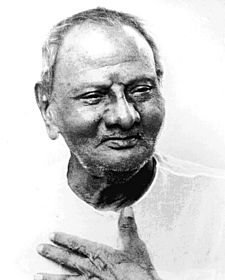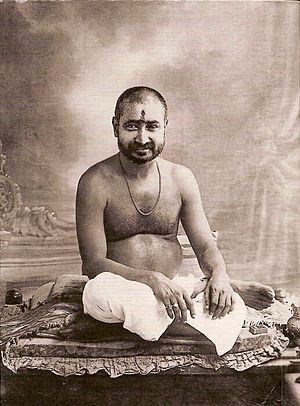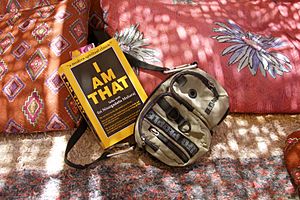Nisargadatta Maharaj facts for kids
Quick facts for kids Nisargadatta Maharaj |
|
|---|---|
 |
|
| Birth Date | 17 April 1897 Bombay, Bombay Presidency, British India |
| Died on | 8 September 1981 (aged 84) Mumbai, India |
| Birth name | Maruti Shivrampant Kambli |
| Guru/teacher | Siddharameshwar Maharaj |
| Philosophy | Advaita Vedanta Nath Shaivism |
Establish yourself firmly in the awareness of 'I AM'. This is the beginning, and also the end of all endeavour.
Nisargadatta Maharaj (born Maruti Shivrampant Kambli) was an important Indian spiritual teacher. He lived from 1897 to 1981. He taught about nondualism, which means understanding that everything is one and not separate.
He belonged to a special group of teachers called the Inchagiri Sampradaya. This group is part of older traditions like the Navnath Sampradaya. His teachings became very famous around the world. This happened after his talks were translated into English in a book called I Am That in 1973.
Contents
Biography
Early life
Nisargadatta was born on April 17, 1897, in Mumbai (then called Bombay). It was a special day called Hanuman Jayanti, the birthday of the Hindu god Hanuman. So, he was named 'Maruti' after Hanuman.
His parents were followers of the Varkari tradition. This was a religious group that worshipped Vithoba and believed everyone was equal. His father worked in Mumbai and later became a small farmer.
Maruti grew up in a village called Kandalgaon in Maharashtra. He had two brothers and four sisters. In 1915, his father died. Maruti then moved to Mumbai to help his family. He first worked as a clerk. Soon, he opened a small shop selling beedis (leaf-rolled cigarettes). He eventually owned eight shops. In 1924, he married Sumatibai. They had three daughters and one son.
Spiritual Journey
In 1933, a friend introduced him to his guru (spiritual teacher), Siddharameshwar Maharaj. His guru told him, "You are not what you think you are." Siddharameshwar taught him a special meditation and a mantra (a sacred sound or phrase). Nisargadatta started repeating it right away.
His guru also told him to focus on the feeling "I am." Nisargadatta followed these instructions very carefully. He later said:
My Guru told me to pay attention to the feeling 'I am' and nothing else. I just obeyed. I didn't do any special breathing or study books. Whatever happened, I would turn my attention away from it and stay with the feeling 'I am'. It might seem too simple. I did it only because my Guru told me. But it worked!
He spent hours focusing on "I am." He also practiced meditation and sang devotional songs called bhajans. He felt a deep sense of peace and joy.
His guru, Siddharameshwar Maharaj, passed away in 1936. In 1937, Maharaj traveled across India for eight months. When he returned to Mumbai in 1938, he felt a big change. He realized that "nothing was wrong anymore." He lived the rest of his life in Mumbai, keeping one shop to support himself.
Later years
Between 1942 and 1948, Nisargadatta faced sad times. His wife, Sumatibai, died, and then his daughter passed away.
In 1951, he started to teach others. He did this after having a special inner experience from his guru. After he retired from his shop in 1966, Nisargadatta Maharaj continued to teach visitors at his home. He gave talks twice a day. He passed away on September 8, 1981, at 84 years old, from throat cancer.
Teachings
Style of teaching
Nisargadatta gave talks and answered questions in his small flat in Mumbai. He had a special room for his students and visitors. This room was also used for daily chants, devotional songs, and meditation.
His tradition, the Inchagiri Sampradaya, first focused on mantra meditation. But later, it shifted to a type of Self-enquiry (looking deeply into oneself). Nisargadatta still gave mantra initiations. He taught that the mantra was more than just a sound; it was the Absolute (the ultimate reality) itself.
For his Western students, Nisargadatta often taught through questions and answers. Many of his talks were recorded. These recordings became the basis for his famous book, I Am That, and other books.
Awareness of true nature

Nisargadatta's main teaching was about our true identity. He said we are not just our bodies or minds. We are the "Absolute Awareness," which is without birth or death, infinite and eternal. He believed our only "problem" is thinking we are separate individuals. But really, we are always and only the Absolute.
Nisargadatta explained:
The life force and the mind work on their own. But the mind will try to make you believe it is "you." So, always understand that you are the timeless, spaceless witness (observer). Even if the mind tells you that you are the one acting, don't believe it. The body and mind that are working have come upon your true self, but you are not that body or mind.
He also explained three levels of consciousness:
- Jivatman: This is when someone thinks they are just a body and a separate person. They feel cut off from the world.
- Atman: This is the feeling of just "being" or "consciousness." It includes the whole world. "I Am" means my entire world.
- The Ultimate Principle: This is the highest state. It is beyond words and cannot be described. It is the source of everything.
He used an example: "I have a grandson (Jivatman). I have a son, and I am the grandfather. The grandfather is the source of the son and grandson." He said that true knowledge begins at the "beingness" level.
Self-enquiry
Nisargadatta taught that we can find our true nature by looking deeply within ourselves. This means letting go of the idea of "me and my world." He called this atma-vicara (self-inquiry) and vijñana (supreme wisdom). He said, "My way is to stay in the Self."
He advised, "Why don't you ask yourself how real the world and the person are?" He often spoke about the importance of truly believing in one's true nature. Without this self-knowledge, he said, one would continue to suffer.
Devotion and mantra repetition
Nisargadatta felt that just thinking about spiritual truths was not enough. He deeply respected his own guru. He suggested the path of devotion, called Bhakti Yoga, to some visitors. He believed that the path of knowledge, Jnana yoga, was not the only way to find truth.
He also stressed the importance of loving one's Guru and God. He encouraged repeating mantras and singing bhajans (devotional songs).
Scriptures
Nisargadatta often read important Marathi spiritual books. These included works by Nath saint Dnyaneshwar and Varkari Sants like Eknath and Tukaram. He also studied the Yoga Vasistha, writings by Adi Shankara, and some major Upanishads.
Nisarga Yoga
Nisargadatta taught a practice called Nisarga Yoga. "Nisarga" means "nature." In his book I Am That, Nisarga Yoga is described as living life with "harmlessness," "friendliness," and "interest." It means being "spontaneously aware" and living "effortlessly."
This practice involves meditating on your sense of "I am," "being," or "consciousness." The goal is to reach the ultimate source of this feeling, which Nisargadatta called the "Self."
The book I Am That explains:
"This dwelling on the sense ‘I am’ is the simple, easy and natural Yoga, the Nisarga Yoga. There is no secrecy in it and no dependence; no preparation is required and no initiation. Whoever is puzzled by his very existence as a conscious being and earnestly wants to find his own source, can grasp the ever-present sense of ‘I am’ and dwell on it assiduously and patiently, till the clouds obscuring the mind dissolve and the heart of being is seen in all its glory."
Nisargadatta did not give one strict method for self-knowledge. He advised his students, "Don't pretend to be what you are not, don't refuse to be what you are." He said that the names of Hindu gods like Shiva, Rama, and Krishna were like nature (Nisarga) in human form. He taught that all life comes from the same non-dual source or Self. Remembering this source was the main part of his message.
He said:
‘You are not your body, but you are the consciousness in the body, because of which you have the awareness of ‘I am’. It is without words, just pure beingness. It has become soul of the world. In the absence of your consciousness, the world will not be experienced. Hence, you are the consciousness… remember what you have heard… meditate on it. Meditation means you have to hold consciousness by itself. The consciousness should give attention to itself. This consciousness is Ishwara. As there is no God other than this consciousness, worship it.’ ‘The knowledge “I am” is God. It is Ishwara, as well as maya. Maya is God’s power. All the names of God are of this consciousness only in different forms. Remember the fact “I am not the body” and get firmly established. That is the sign of a true seeker.’
Here are seven principles of Nisarga Yoga:
- Non-identification and right understanding
- Interest and earnestness
- Spontaneity and effortlessness
- Attentiveness to being
- Right action
- Going within to go beyond
- Awareness of Self
Lineage
Disciples
Many people became Nisargadatta's students. Some of his well-known students include Maurice Frydman, Sailor Bob Adamson, Jean Dunn, and Ramesh Balsekar. Sri Ramakant Maharaj is another student who spent 19 years with Nisargadatta. He says he is the only direct Indian student who offers initiation into this teaching line.
Successors
David Godman shared how Nisargadatta explained the line of teachers in his tradition. He said that hundreds of years ago, teachers did not hold big meetings. They traveled on foot from village to village. They would meet students and give them a mantra. The students would repeat the mantra, and the teacher would check on their progress. When a teacher was about to pass away, they would choose a new teacher from their householder students.
Nisargadatta himself explained that the Navnath Sampradaya is a way of teaching and practice. He said, "If you accept a Navnath Sampradaya teacher as your Guru, you join his Sampradaya. Usually you receive a token of his grace - a look, a touch, or a word, sometimes a vivid dream or a strong remembrance."
DVDs
- Awaken to the Eternal, Nisargadatta Maharaj: A Journey of Self-Discovery. 1995.
See also
 In Spanish: Nisargadatta Maharaj para niños
In Spanish: Nisargadatta Maharaj para niños



